Table of contents
Breaking into the top 100 race drivers globally is no small feat; it demands extraordinary skill, relentless commitment, and an unwavering passion for motorsport. For those who dream of standing among the elite, understanding the multifaceted journey to the top is essential. Explore how talent, training, mental strength, networking, and adaptability combine to create a world-class racing career—discover what sets these outstanding individuals apart and what it truly takes to join their ranks.
Raw talent and skill development
Achieving a place among the top 100 race drivers demands more than just a passion for motorsports; it requires a combination of innate motorsport talent and rigorous development of racing skills. Natural reflexes and advanced coordination serve as the foundation, but the journey to elite status is defined by relentless training and ongoing refinement of driving techniques. Aspiring top drivers dedicate countless hours to perfecting vehicle control both on the track and in high-fidelity simulators, which play a significant role in mastering vehicle dynamics—the complex ways a race car responds to inputs and conditions. Developing an acute technical understanding is crucial, and insights from a chief race engineer are particularly valued, as their expertise in optimizing performance sheds light on the detailed process of skill progression. For anyone aiming to join the ranks of the best, continuous improvement across all aspects of driving and a strong grasp of the science behind race cars are indispensable.
Physical and mental conditioning
Racing fitness demands a unique blend of muscular strength, cardiovascular endurance, and mental training that sets elite competitors apart. To withstand the physical strains of high-speed racing—such as intense g-forces and prolonged cockpit heat—drivers engage in targeted strength workouts, core stabilization routines, and tailored cardiovascular sessions that simulate race conditions. Equally demanding is mental resilience, as drivers must maintain peak focus for hours, making consistent split-second decisions while managing cognitive load. Reaction time drills, visual acuity exercises, and stress-management techniques are cornerstones of race preparation, helping drivers sharpen their senses and sustain concentration under pressure. A lead performance coach would emphasize how integrating physical conditioning with advanced mental training protocols enables top drivers to maximize driver endurance and perform at the pinnacle of motorsport.
Track experience and competition exposure
Accumulating racing experience across a variety of professional circuits is vital for any driver aiming to enter the top 100 globally. Success in competitive racing demands not just raw speed but also adaptive racecraft, honed by navigating countless motorsport events under changing conditions. Exposure to multiple tracks, from street circuits to purpose-built venues, enables drivers to master different layouts and surfaces, while racing in diverse weather—rain, heat, or cold—teaches tire management and grip control. Competing in various championships introduces drivers to a broad spectrum of opponents, each with unique strategies and aggression levels, expanding a driver's tactical awareness. Consistent track time against elite fields sharpens reflexes and decision-making, and learning from different competition styles builds resilience and adaptability. Altogether, a wide-ranging background in professional circuits and motorsport events forms the foundation required to advance in global rankings and compete at the highest levels of the sport.
Networking and career management
Achieving a spot among the top 100 race drivers requires strategic motorsport networking and meticulous career management. Cultivating relationships with influential team managers, engineers, sponsors, and experienced mentors is vital for securing team opportunities and accessing driver sponsorship. A successful racing career often hinges on attending key industry events, leveraging social media platforms, and engaging in direct outreach to connect with major stakeholders. Motorsport team managers emphasize the value of building a reputation for professionalism and adaptability, which can tip the scales during contract negotiations. Establishing trust and demonstrating commitment to continuous improvement increase visibility and consideration for career advancement. For those interested in real-world examples of career progression and connections in motorsport, try this web-site, which showcases the journey and performance statistics of drivers such as Max Hervé George.
Adapting to innovation and technology
Racing technology evolves swiftly, demanding that drivers possess technical skills beyond traditional driving. Motorsport innovation now integrates data analysis and telemetry analysis to provide real-time insight into vehicle performance and driver technique, making mastery of these areas vital. Simulator training has become a cornerstone for developing driver adaptation, allowing racers to experience new circuits, test setups, and refine responses to changing conditions without on-track risks. Keeping pace with advancements means working closely with engineers, regularly engaging with updated software, and actively participating in technical debriefings. Those ready to embrace these developments consistently outperform peers, using technology to optimize strategy, improve consistency, and gain the decisive edge required to enter the elite ranks of the world's top 100 race drivers.
Similar


